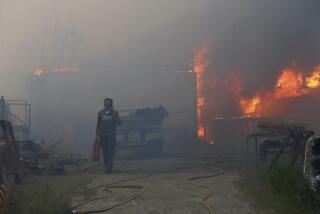Australian fire toll is growing
- Share via
SYDNEY, AUSTRALIA — Warm winds whipped up clouds of embers today that threaten to spread southern Australia’s wildfires into more towns, as dozens more dead were found in the smoldering ashes of earlier blazes.
At least 173 people have been confirmed dead, and with search teams recovering more charred corpses in fire-scorched areas, police warned that the final death toll in what is already the country’s worst fire disaster could reach 300.
Thousands of firefighters have brought numerous blazes under control as temperatures dropped in Victoria state, but renewed high winds threaten to fan flames in central Victoria. Police have warned residents of Healesville, a popular tourist destination, that embers from a fire on its outskirts could spark blazes in the town at any time.
Alan Downie, manager of the Best Western Motel in Mill Park, said many displaced people had arrived from Kinglake.
“Most of them are here because their homes have been destroyed or they’re not allowed back,” Downie said. “We suspect most of them have lost everything.”
On Monday, Victorian Premier John Brumby announced a royal commission of inquiry into the still-unfolding catastrophe. Normally headed by judges with broad investigative powers, royal commissions can work for months to provide a detailed analysis of issues and events and recommend policy changes to government.
Brumby vowed that “everything will be on the table” for the inquiry, including the “stay and defend” policy that encourages residents to evacuate as early as possible or prepare to defend their homes from advancing wildfires.
Police are conducting separate investigations into suspected arson in several of the fire zones, where a total of more than 1,200 square miles of forest, towns and farmland have been destroyed. Australian Prime Minister Kevin Rudd has called the disaster “mass murder.” Blazes have destroyed 750 houses and left 5,000 people homeless.
In the town of Marysville, which was almost wiped out over the weekend, rain fell briefly. The town has been declared a crime scene, and police are searching for evidence of arson.
Survivors of the infernos have described watching distant orange glows on the skyline suddenly speed toward them as roaring walls of flame that left little or no time to escape.
The burned corpses of some victims have been found in the charred wrecks of cars consumed by blazes as high as four stories that devastated towns northeast of Melbourne.
Victoria’s premier defended the policy of permitting homeowners to stay and try to protect their property, often with nothing more than garden hoses against fires so huge that they easily overwhelmed professional firefighters.
The “stay and defend” policy “has served the state very well in what I’d call normal conditions,” Brumby told Australian television.
Before the inferno erupted Saturday during a heat wave that pushed temperatures to 115 degrees, conditions didn’t seem that unusual to residents who have grown used to blistering heat and extremely dry conditions after several years of drought.
But the extreme speed of the wildfires proved too much for many of the victims who tried to flee, said Andrew Sullivan, a bush fire specialist at Australia’s Commonwealth and Scientific Research Organization.
“The plain fact of the matter is, being in a house is much safer than being in a car, which is much safer than being in the open,” Sullivan said.
Gary Hughes, a longtime reporter for The Australian newspaper, wrote of the speed with which the fire engulfed his home in St. Andrews, 22 miles northeast of Melbourne, in the Kinglake area that was razed by walls of fire.
“It comes at you like a runaway train. One minute you are preparing. The next you are fighting for your home,” he wrote. “Then you are fighting for your life.”
Hughes was one of many rural residents who looked after injured wildlife, and the birds he was caring for were killed in the flames. The situation was the same throughout the affected area, said Michelle Manhal, a conservationist with Help for Wildlife.
The organization expects to spend weeks searching for injured animals and months rehabilitating wildlife, which had already suffered during the heat wave.
“We’re dealing with everything: koalas, wombats, kangaroos, wallabies, glider species, birds, so virtually everything across the board, but predominantly marsupial species,” Manhal said.
“Most birds get out unhurt, but unfortunately there are those that are dealing with smoke inhalation. And then you’ve got species that’ve been trying to deal with the hot temperatures, which are flying foxes and fruit bats and possums, so we’ve had thousands and thousands of those die.”
The combination of population decimation and the destruction of the environment means it could take years for species in the area to recover. The number of flying foxes and possums in some areas is estimated to have been halved.
“The ones that are there have got to breed, so the environment has to be well enough for them to breed . . . and once the babies are born, a percentage of the babies have to survive,” she said. “You’re potentially looking at five to 10 years.”
But first, firefighters supported by the Australian army have to defeat the infernos still sweeping through swaths of the south. Authorities said that many fires are unlikely to be extinguished soon.
“Most of the fires are in inaccessible terrain. They’re likely to keep burning for some time,” said fire specialist Sullivan. “All it takes [for it to get worse] is another week or so and we come back to the same heat wave conditions.
“What they need is rain,” Sullivan said, “and that’s not forecast.”
More to Read
Sign up for Essential California
The most important California stories and recommendations in your inbox every morning.
You may occasionally receive promotional content from the Los Angeles Times.










